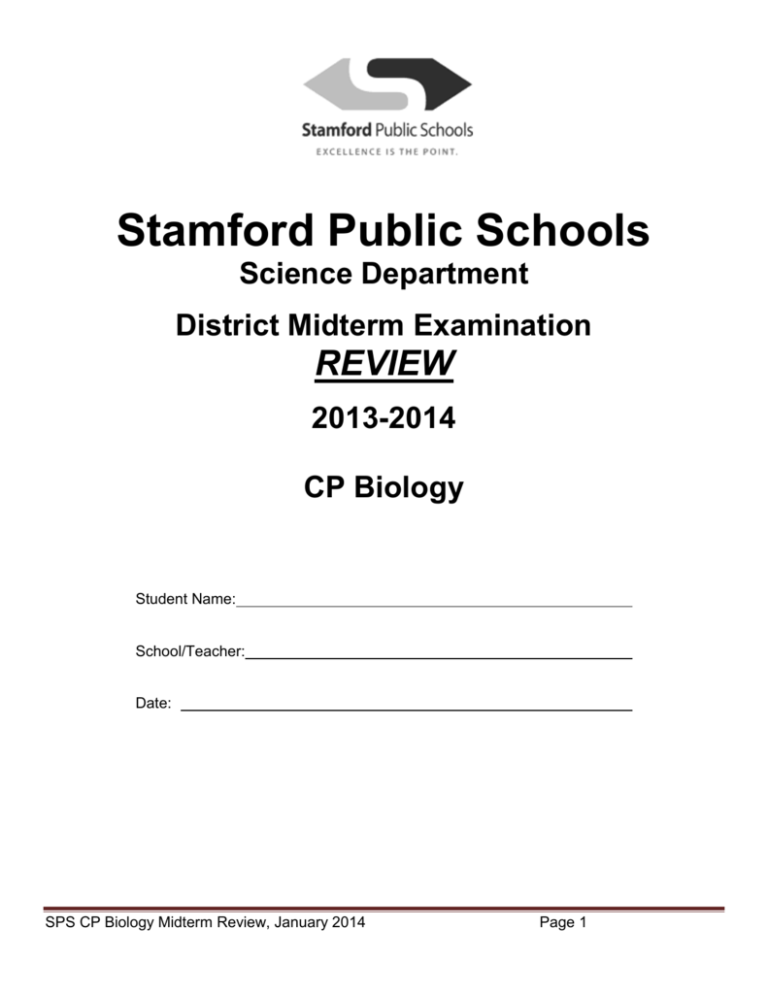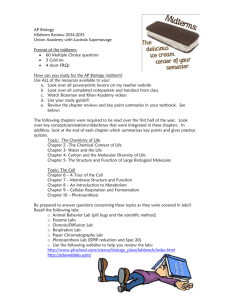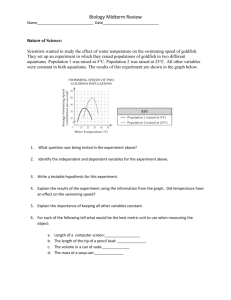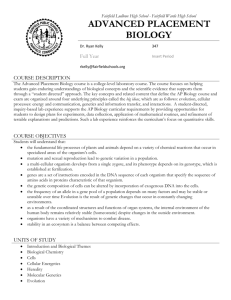CP Biology Midterm Review Packet
advertisement

Stamford Public Schools Science Department District Midterm Examination REVIEW 2013-2014 CP Biology Student Name: School/Teacher: Date: SPS CP Biology Midterm Review, January 2014 Page 1 Dear Biology Student, The district-wide CP Midterm Exam for the 2013-2014 school year will focus on the concepts covered in each of the first two quarters of the Biology course. You will have 90 minutes for this exam. Enclosed is a list of the skills and concepts from your Biology course. Next to each main topic is the number of problems which will appear on the Exam and also the way questions will be formatted (Constructed Response or Selected Response). In addition to the concepts listed and the formatting of the questions, this packet also includes a sampling of the types of questions which will be on your CP Biology Midterm Exam. Please see your science teacher if you feel additional practice is necessary. Wishing you success on your Exam, Carrie Chiappetta Director School Improvement and Professional Development-Secondary SPS CP Biology Midterm Review, January 2014 Page 2 CP Biology Midterm Exam 2014 Blueprint and Study Guide 62 Selected Responses 1 point each (62 total points) 8 Constructed Responses 1-5 points each (total 22 points) 84 Total Points Topic Scientific Inquiry General content regarding scientific inquiry, literacy and numeracy. Population Ecology Human population growth Carrying capacity Limits to population size Birth rate/death rate Human influence on global warming Human population pyramids Interpreting Predicting Developed vs. underdeveloped The Chemistry of Life Enzyme function and structure Activation energy pH scale buffers Synthesis of macromolecules Structure and function of macromolecules Interpreting Enzyme Lab Data The Structure and Function of Cells Homeostasis Properties of life Eukaryotic vs Prokaryotic cells Plant vs Animal cells Parts of the Eukaryotic Cell and their functions Passive and Active Transport Diffusion Osmosis (hypotonic, hypertonic, isotonic) Identifying solutions Predicting movement of water SPS CP Biology Midterm Review, January 2014 # of selected response questions 6 total # of constructed response questions 0 total points for constructed response questions 0 points total 6 total 2 1 total 3 points total 2 1 1 1 7 total 1 2 total 10 points total 2 0 total 0 points total 2 1 3 15 total 1 3 2 2 8 1 1 Page 3 Respiration and Photosynthesis Equations of Respiration & Photosynthesis Reactants and Products of: Glycolysis ETC Kreb’s cycle Light reactions Dark reactions (Calvin Cycle) Aerobic vs. Anaerobic respiration Location of processes ATP DNA Structure and Function of DNA Parts of a DNA nucleotide Base pairing rules Replication Protein Synthesis Structure and Function of RNA Parts of an RNA nucleotide Base pairing rules Codons and amino acids Transcription Translation 6 total 2 0 points total 1 total 1 4 points total 0 total 0 points total 0 total 0 points total 0 total 0 points total 3 1 5 total 3 1 1 5 total 2 2 1 Cell Division Mitosis Stages of the cell cycle Stages of Interphase Processes occurring during the cell cycle Processes occurring during Interphase Parent vs Daughter cells Genetic information Chromosome number 4 total 3 Sexual Reproduction Meiosis Crossing over Parent vs. Daughter cells Genetic information Chromosome number Sources of genetic variability 3 total 3 SPS CP Biology Midterm Review, January 2014 0 total 1 Page 4 Found in conjunction with questions throughout the assessment The Nature of Science Scientific Method Experimental components Constant Control Independent Dependent Hypothesis Interpreting and Graphing data 4 total 5 points Science Process You should be able to: Design experiments that test specific science questions Identify the independent/dependent variables and control if applicable Demonstrate a knowledge of common lab equipment and measurement units Write a reasonable hypothesis based on prior knowledge Read and interpret graphs, tables and diagrams Analyze data and observations to form reasonable conclusions Demonstrate an understanding of error related to the validity of data Apply mathematics to solving quantitative problems as applied to science Use common science language and vocabulary correctly Find logical connections between science concepts and applications in the real world. Evaluate information based on science practice Identify and emphasize interdisciplinary connections Explain how science understanding is challenged and developed through rigorous testing of concepts, theories and laws CP Biology Midterm Exam 2014 Blueprint and Study Guide 1. Explain the relationship between an independent variable and a dependent variable. 2. Use the following terms in the same sentence: observation, hypothesis, prediction and experiment. 3. Summarize the parts of a controlled experiment. SPS CP Biology Midterm Review, January 2014 Page 5 4. Which of the following is the dependent variable in the experiment? a. Twilight b. Complete darkness c. Daylight d. Distance from target 5. List the five main levels of organization in ecology. 6. How does a population differ from a community? 7. Why is the amount of light important to the animals in an ecosystem? 8. Which of the following is a population? a. All the fish in a pond c. all the members of a family of humans b. All the birds of New York City d. all of the fish of the same species in a lake 9. Explain how two populations can be the same size but have different densities. 10. Explain the relationship between birth rate, death rate and growth rate. 11. List two density-independent factors that could limit population growth. 12. What effect did the agricultural revolution have on the growth of the human population? 13. Compare living standards in developing countries with those in developed countries. SPS CP Biology Midterm Review, January 2014 Page 6 14. In the graph, which time period shows negative growth of the population? a. Phase 1 b. Phase 2 c. Phase 3 d. Phase 4 15. Identify the reactants and the products in the following chemical reaction. A + B C + D 16. Name two ions that are the products of the dissociation of water. 17. The amount of energy needed for this chemical reaction to begin is shown by the line rising from the reactants. What is this energy called? a. Chemical energy c. activation energy b. Electrical energy d. mechanical energy SPS CP Biology Midterm Review, January 2014 Page 7 18. Suppose that the reaction above needs a catalyst to proceed. In the absence of a catalyst, the activation energy would be which of the following? a. Larger than what is shown c. Smaller than what is shown b. The same as what is shown d. not much different from what is shown 19. Differentiate between organic and inorganic compounds. 20. Explain the role of ATP in cellular activities. 21. List the four major classes of organic compounds. 22. For each pair of terms. Explain how the meanings of the terms differ. a. Monomer and polymer b. Monosaccharide and disaccharide c. Polypeptide and protein d. Nucleic acid and nucleotide 23. State the three fundamental parts of the cell theory. 24. Name eight characteristics that all living things share. 25. Identify the three main parts of an eukaryotic cell. 26. List four levels of organization that combine to form an organism. 27. For each pair of terms, explain how the meanings of the terms differ: a. nucleolus and nucleus b. cell wall and cell membrane c. ribosomes and endoplasmic reticulum d. chromatin and chromosomes e. mitochondria and chloroplast 28. What is the function of the structure labeled 1? a. To make ATP c. To make proteins b. To make carbohydrates d. To move proteins through the cell SPS CP Biology Midterm Review, January 2014 Page 8 29. During diffusion, molecules tend to move in what direction? a. The molecules involved in diffusion never move b. In a direction that doesn’t depend on the concentration gradient c. From an area of lower concentration to an area of higher concentration d. From an area of higher concentration to an area of lower concentration 30. Distinguish between passive and active transport. 31. Explain why both autotrophs and heterotrophs depend on photosynthesis to obtain the energy they need for life processes. 32. Explain why the splitting if water is important to the continuation of the light reactions. 33. What are the reactants and products for both the light reactions and the Calvin cycle? 34. List the two processes that together result in cellular respiration. 35. Describe what causes your muscles to become fatigued and sometimes develop cramps when you exercise too strenuously. 36. At which of the points is ATP, the main energy currency of the cell, produced? a. 1 only b. 2 only c. 1 and 3 d. 1, 2 and 3 37. Describe the structure of the chromosome. 38. Summarize the events of interphase. 39. Use the following terms in the same sentence: mitosis, meiosis and cytokinesis. 40. How do the end products of meiosis differ from the end products of mitosis? 41. How do the base-pairing rules relate to structure of DNA? 42. List the four ways in which the structure of RNA differs from that of DNA. 43. For each pair of terms, explain how the meanings of the terms differ: a. purine and pyrimidine b. messenger RNA and transfer RNA c. transcription and translation 44. Sequence the main steps of transcription and translation. SPS CP Biology Midterm Review, January 2014 Page 9 CP Biology Midterm Vocabulary List 1. Acidic 32. Environment 63. Nucleotide 2. Activation Energy 33. Enzymes 64. Nucleus 3. Active Transport 34. Eukaryotes 65. Observation 4. Adenine 35. Fermentation 66. Organ Systems 5. Amino Acids 36. Gamete (egg/sperm) 67. Organelles 6. Anaphase 37. Genotype 68. Organic Compound 7. Animal Cell 38. Glucose (C6H12O6) 69. Organisms 8. ATP 39. Glycolysis 70. Organs 9. Basic 40. Golgi Apparatus 71. Osmosis 10. Biology 41. Guanine 72. O2 11. Birth Rate 42. Heterozygous 73. Passive Transport 12. Cancer 43. Homeostasis 74. pH 13. Carbohydrate 44. Homologous Pairs 75. Photosynthesis 14. Carrying Capacity 45. Homozygous 76. Plant Cell 15. Catalysts 46. Hybrid 77. Population 16. Cell 47. Hypothesis 78. Prokaryotes 17. Cell Membrane 48. Immigration 79. Prophase 18. Cell Theory 49. Independent Variable 80. Protein 19. Chloroplasts 50. Interphase 81. Ribosomes 20. Chromosome 51. Krebs Cycle 82. RNA 21. CO2 52. Lactic Acid 83. Scientific Experiment 22. Control group 53. Limiting Factor 84. Selectively Permeable 23. Cytoplasm 54. Living 85. Species 24. Cytosine 55. Lysosomes 86. Telophase 25. Death Rate 56. Meiosis 87. Theory 26. Dependent Variable 57. Metaphase 88. Thymine 27. Diffusion 58. Mitochondria 89. Tissue 28. DNA 59. Molecules 90. Transcription 29. DNA Replication 60. Monomers 91. Translation 30. Emigration 61. Neutral 92. Uracil 31. Endoplasmic Reticulum 62. Niche 93. Vacuole SPS CP Biology Midterm Review, January 2014 Page 10








